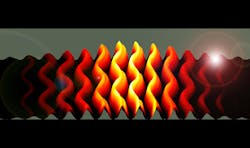Breathing soliton laser reveals synchronization dynamics
An international team of researchers from East China Normal University, Aston University, and Université de Bourgogne Franche-Comté are using a brand new concept for femtosecond lasers—a breathing soliton laser—to explore the complex synchronization dynamics of nonlinear systems with multiple frequencies, a.k.a. many-body interactions (see video).
Typically, the synchronization of the many optical resonators (lasers) involved in synchronization work is extremely challenging because the cavity length mismatch between lasers must be tightly controlled (at the micron level). But a breathing soliton laser has multiple internal competing frequencies—so only one laser is required for the job.
What’s a breathing soliton laser? Standard mode-locked fiber lasers emit identical pulses over time, which are called solitons. Under certain conditions, a mode-locked fiber laser can also emit pulses with time-varying energies, which are known as “breathing solitons” due to their periodicity.
Simple design, easy to operate
The design of the team’s breathing soliton laser “is no more than a standard mode-locked fiber laser,” explains Junsong Peng, a professor at East China Normal University’s State Key Laboratory of Precision Spectroscopy. “In fact, these pulses are very common. Every standard mode-locked fiber laser can emit such pulses, but the key is to tune the laser parameters—such as the pump power—carefully. If you don’t want to tune it manually, machine learning techniques can do it for you, which we showed in earlier work.”
In their latest work, the team reveals new dynamics at play within many-body systems. “We discovered a new state of nonlinear systems—modulated subharmonics—that’s an intermediate state between synchronized and desynchronized states,” explains Peng. “In other words: this state contains both synchronized and desynchronized signals.”
Such a state is expected to be observed in many nonlinear systems, and could contribute to the understanding of the mechanisms of instabilities within these systems. “Equally important, this state manifests the three competing frequencies—the cavity repetition rate (determined by laser length), the subharmonic frequency, and its modulation frequency—opening the possibility of exploring the three competing frequencies, which is a many-body problem in nonlinear science, within a single oscillator,” says Peng. “You don’t need to build three oscillators like before.”
The desynchronized state in the team’s many-body system is special. “While the multiple breathing solitons as a whole aren’t synchronized to the laser cavity (they’re desynchronized), the pulses themselves are synchronized to each other,” says Peng. “And we show that the locking range of the synchronized state increases with the number of breathing solitons.”
Previously, three resonators were required to explore the dynamics of three internal competing frequencies within nonlinear synchronization science. But the team accomplishes it with one breathing soliton laser—and observed 11 different laser states when they varied the pump current within the range of 40 milliamps.
Peng and colleagues were stunned to see the 11 different laser states, which they went on to reproduce in numerical simulations—via a standard laser model. “Our simulations give us valuable insights into the laser dynamics, because experiments can’t access details like the evolution of the pulses inside the laser cavity,” says Peng. “With the assistance of the simulation, it feels like we’ve finally built a bridge to go explore the beauty and mystery across the river.”
One of the biggest challenges for the team was that the numerical simulations are necessary to reveal temporal dynamics of the breathing solitons inaccessible via experiments. “But the numerical simulation part is very challenging because it must reproduce 11 different laser states successively by tuning one single laser parameter, just like the experiments,” says Peng. “Moreover, some laser parameters in the experiments can’t be known precisely—which adds to the challenge.”
The team overcame these challenges by trial and error processes, but they acknowledge it was a time-consuming effort.
New concept for femtosecond lasers
A breathing soliton laser generates more frequency tones than standard femtosecond lasers within the frequency domain, so it can increase the spectral resolution for spectroscopy. It also shows tremendous potential for fundamental science, such as exploring many-body interactions, as shown by the team’s work.
“Currently, the laser allows us to study three competing frequencies,” says Peng. “A natural question is whether the number of frequencies can be further increased so even more complex dynamics, such as turbulence and chaos, can be explored and understood. Mode-locked lasers can not only be used in practical applications such as ranging, sensing, and material processing, but are also an ideal testbed to explore the physics and nonlinear dynamics of complex systems.”
FURTHER READING
X. Wu, J. Peng, S. Boscolo, C. Finot, and H. Zeng, Phys. Rev. Lett., 131, 263802 (Dec. 29, 2023); https://doi.org/10.1103/PhysRevLett.131.263802.
X. Wu et al., Laser Photon. Rev. (Dec. 13, 2021); https://doi.org/10.1002/lpor.202100191.
About the Author
Sally Cole Johnson
Editor in Chief
Sally Cole Johnson, Laser Focus World’s editor in chief, is a science and technology journalist who specializes in physics and semiconductors.

